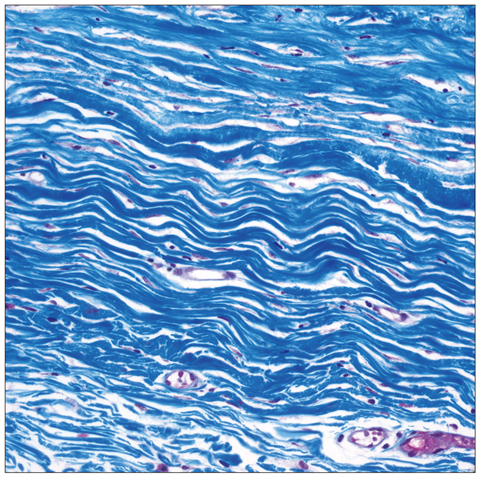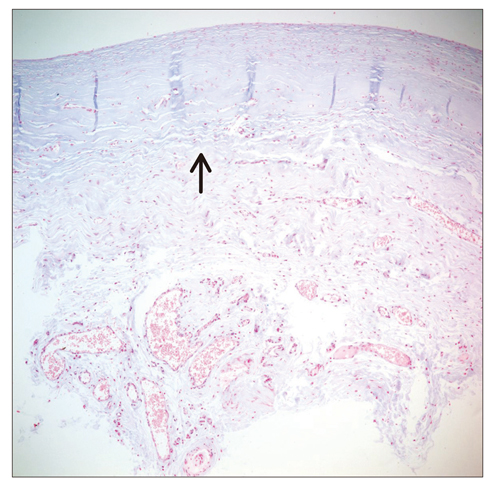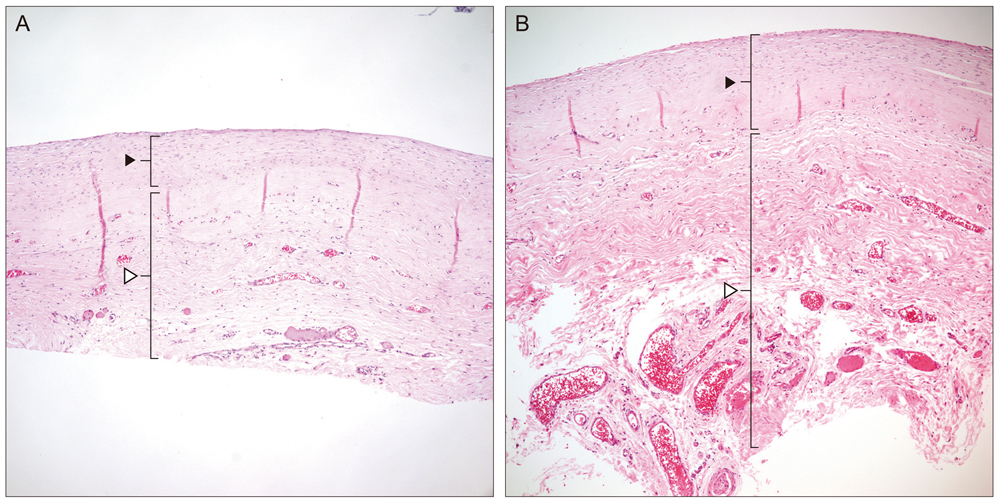Korean J Ophthalmol.
2012 Aug;26(4):265-270. 10.3341/kjo.2012.26.4.265.
Comparative Study of Encapsulated Blebs Following Ahmed Glaucoma Valve Implantation and Trabeculectomy with Mitomycin-C
- Affiliations
-
- 1Department of Ophthalmology, Samsung Medical Center, Sungkyunkwan University School of Medicine, Seoul, Korea. cwkee@skku.edu
- KMID: 1387393
- DOI: http://doi.org/10.3341/kjo.2012.26.4.265
Abstract
- PURPOSE
To compare the histopathologic and morphologic findings of encapsulated blebs following Ahmed glaucoma valve implantation and primary standard trabeculectomy with mitomycin-C.
METHODS
We reviewed the records of patients with otherwise uncontrollable glaucoma who had undergone Ahmed glaucoma valve implantation or trabeculectomy with mitomycin-C. Five eyes that underwent Ahmed valve implantation and three eyes that underwent trabeculectomy needed surgical revision of the initial surgery due to encapsulated bleb development with total loss of function. The surgically removed encapsulated blebs were analyzed macroscopically and microscopically.
RESULTS
Removal of the encapsulated bleb was performed at a mean follow-up time of 26.6 +/- 19.4 weeks in the Ahmed valve implantation group and 12.0 +/- 11.4 weeks in the trabeculectomy group. The fibrotic wall of the encapsulated blebs had an overall thickness of 2.48 +/- 0.42 mm in the Ahmed valve implantation group and 1.62 +/- 0.37 mm in the trabeculectomy group. Macroscopically, the coconut flesh-like smooth surface was split into two layers, and the wall of the capsule was thicker in the Ahmed valve implantation group than in the trabeculectomy group. Histopathologically, the fibrotic capsule was composed of an inner fibrodegenerative layer and an outer fibrovascular layer, and there were no histopathological differences between the two groups.
CONCLUSIONS
The fibrotic capsule wall was thicker in the Ahmed valve group, but there were no differences in histological findings between the two groups.
MeSH Terms
Figure
Reference
-
1. Van Buskirk EM. Cysts of Tenon's capsule following filtration surgery. Am J Ophthalmol. 1982. 94:522–527.2. Richter CU, Shingleton BJ, Bellows AR, et al. The development of encapsulated filtering blebs. Ophthalmology. 1988. 95:1163–1168.3. Azuara-Blanco A, Bond JB, Wilson RP, et al. Encapsulated filtering blebs after trabeculectomy with mitomycin-C. Ophthalmic Surg Lasers. 1997. 28:805–809.4. Campagna JA, Munden PM, Alward WL. Tenon's cyst formation after trabeculectomy with mitomycin C. Ophthalmic Surg. 1995. 26:57–60.5. Cairns JE. Trabeculectomy. Preliminary report of a new method. Am J Ophthalmol. 1968. 66:673–679.6. Watson PG, Barnett F. Effectiveness of trabeculectomy in glaucoma. Am J Ophthalmol. 1975. 79:831–845.7. Addicks EM, Quigley HA, Green WR, Robin AL. Histologic characteristics of filtering blebs in glaucomatous eyes. Arch Ophthalmol. 1983. 101:795–798.8. Feldman RM, Gross RL, Spaeth GL, et al. Risk factors for the development of Tenon’s capsule cysts after trabeculectomy. Ophthalmology. 1989. 96:336–341.9. Schwartz AL, Van Veldhuisen PC, Gaasterland DE, et al. The Advanced Glaucoma Intervention Study (AGIS). 5. Encapsulated bleb after initial trabeculectomy. Am J Ophthalmol. 1999. 127:8–19.10. Molteno AC, Fucik M, Dempster AG, Bevin TH. Otago Glaucoma Surgery Outcome Study: factors controlling capsule fibrosis around Molteno implants with histopathological correlation. Ophthalmology. 2003. 110:2198–2206.11. Thieme H, Choritz L, Hofmann-Rummelt C, et al. Histopathologic findings in early encapsulated blebs of young patients treated with the ahmed glaucoma valve. J Glaucoma. 2011. 20:246–251.12. Eibschitz-Tsimhoni M, Schertzer RM, Musch DC, Moroi SE. Incidence and management of encapsulated cysts following Ahmed glaucoma valve insertion. J Glaucoma. 2005. 14:276–279.
- Full Text Links
- Actions
-
Cited
- CITED
-
- Close
- Share
- Similar articles
-
- Comparison of Outcome of Trabeculectomy With Mitomycin C and Ahmed Valve Implantation for Uveitic Glaucoma
- Surgical Results of Trabeculectomy and Ahmed Valve Implantation Following a Previous Failed Trabeculectomy in Primary Congenital Glaucoma Patients
- Changes in Axial Length Following Trabeculectomy and Ahmed Glaucoma Valve Implantation
- Trabeculectomy with Mitomycin C versus Ahmed Valve Implantation in Pseudophakic Glaucomatous Eyes
- Encapsulated Bleb and Fibrous Ingrowth in the Ahmed Glaucoma Valve System and Bleb Revision with Mitomycin-C






